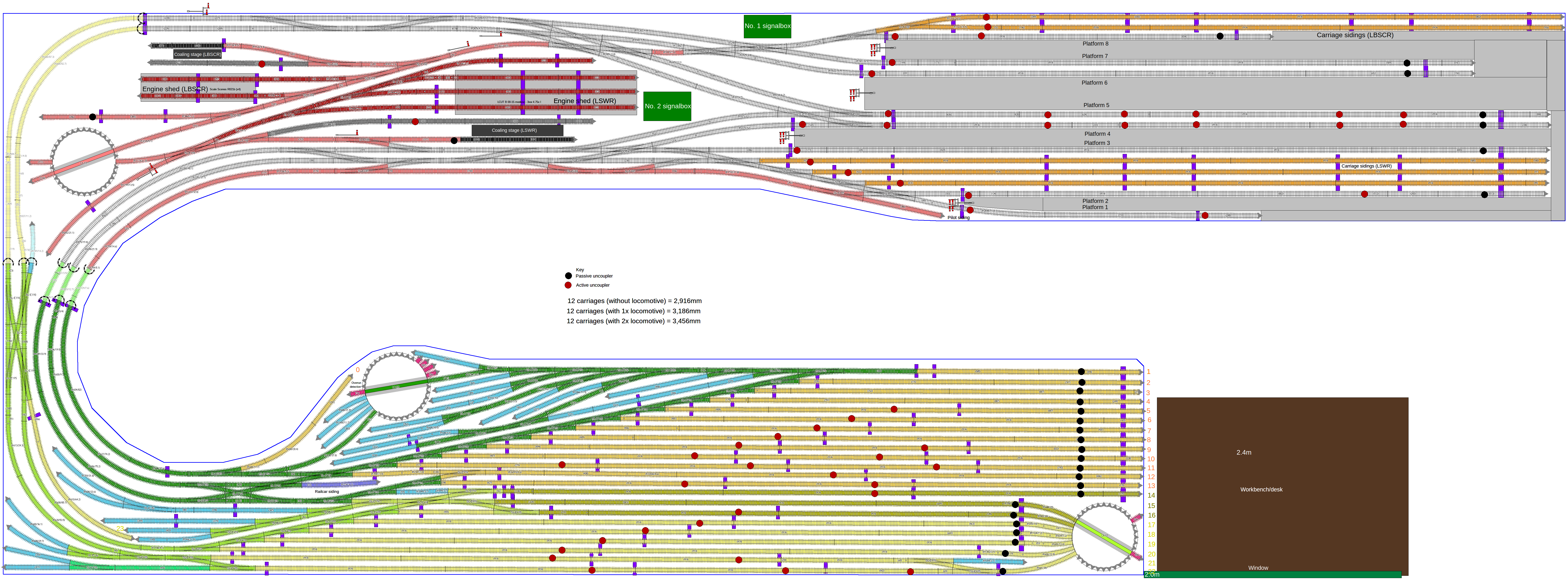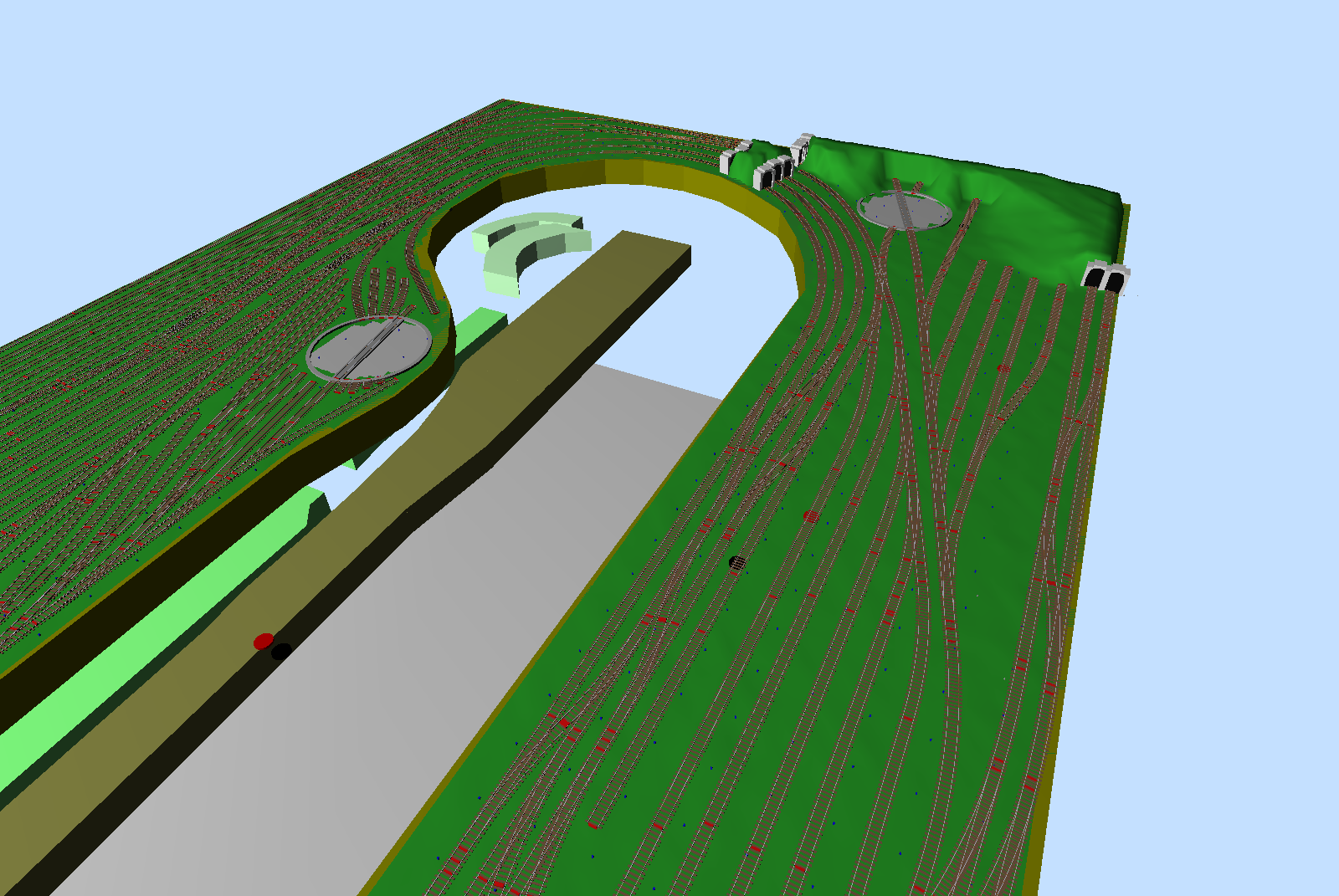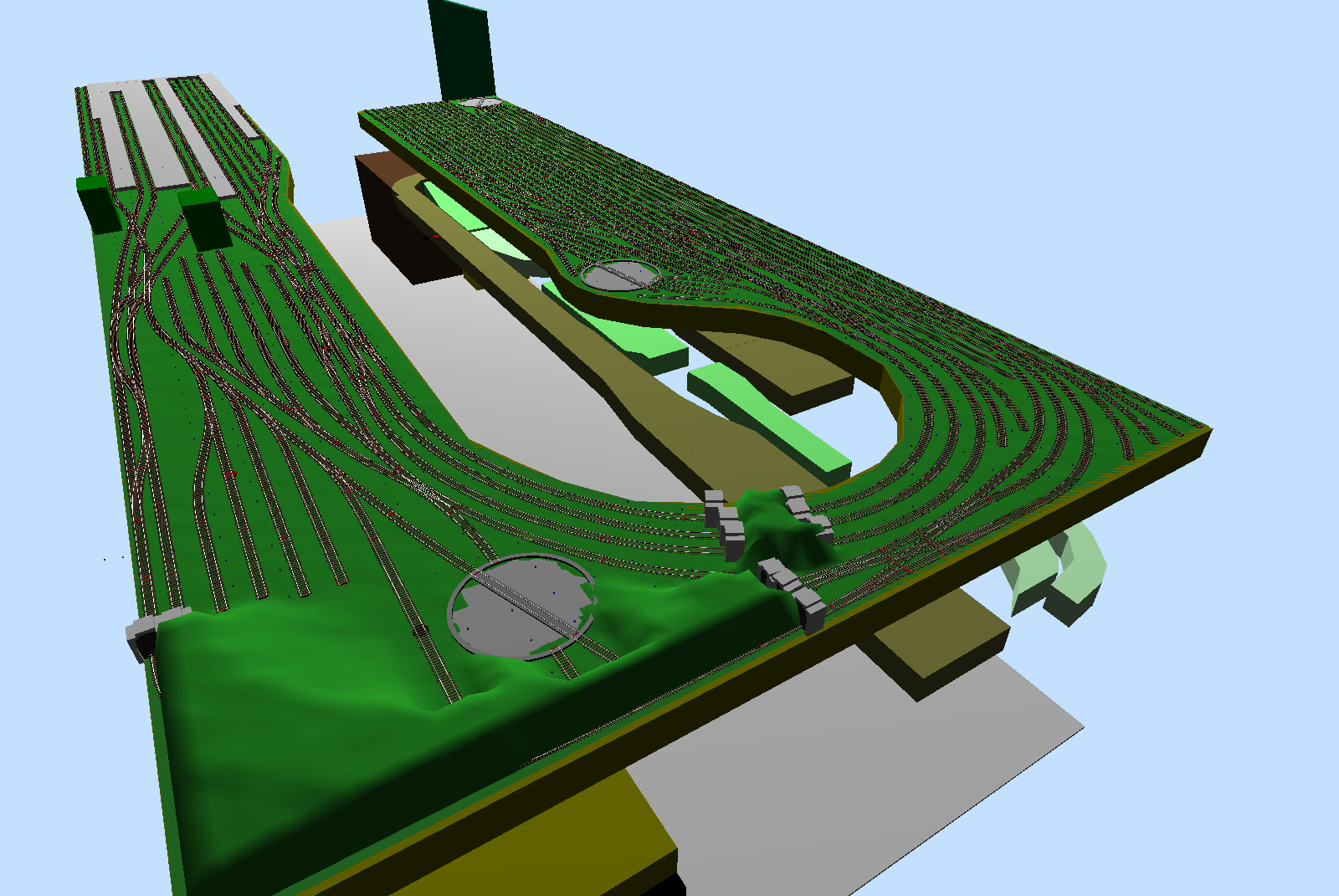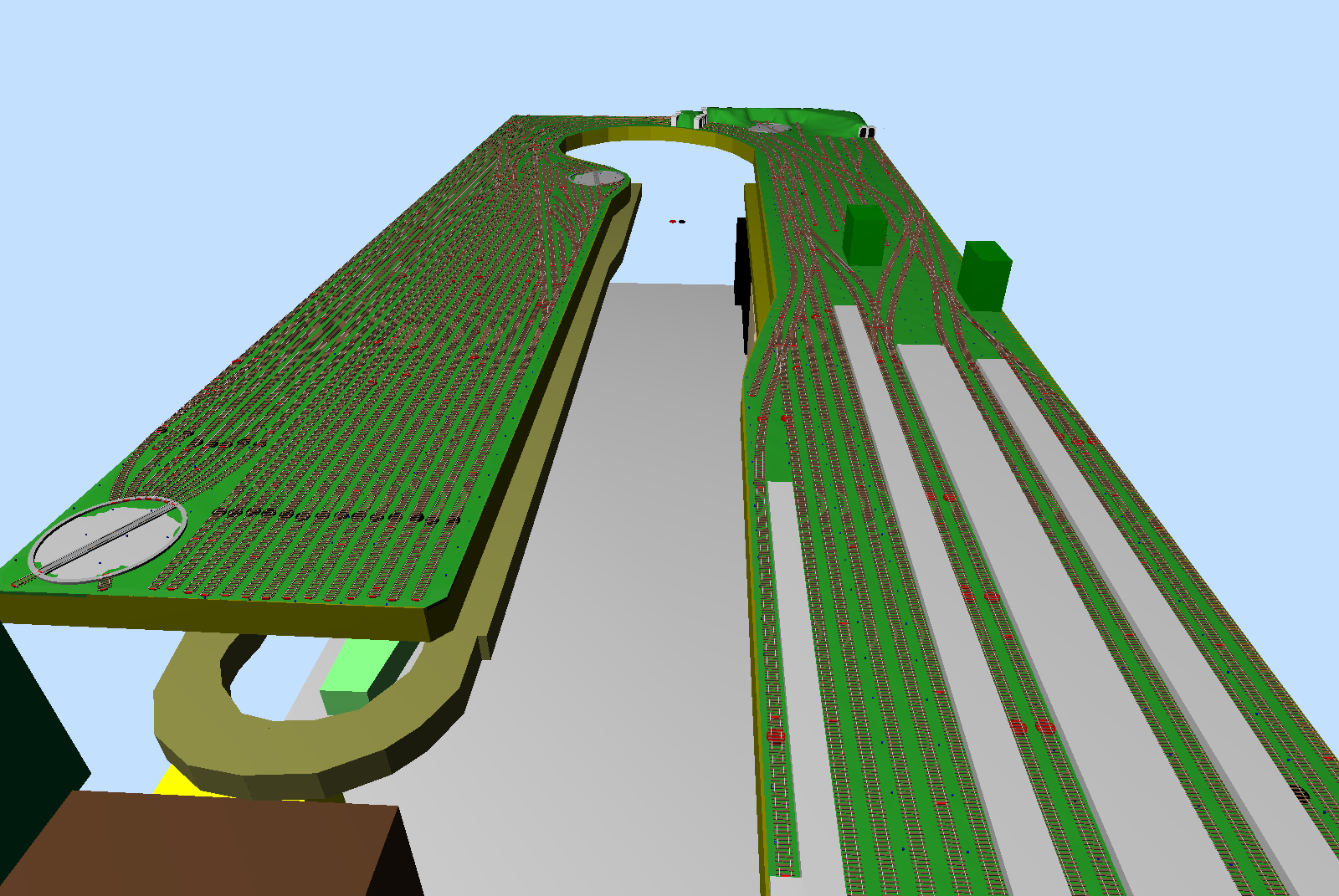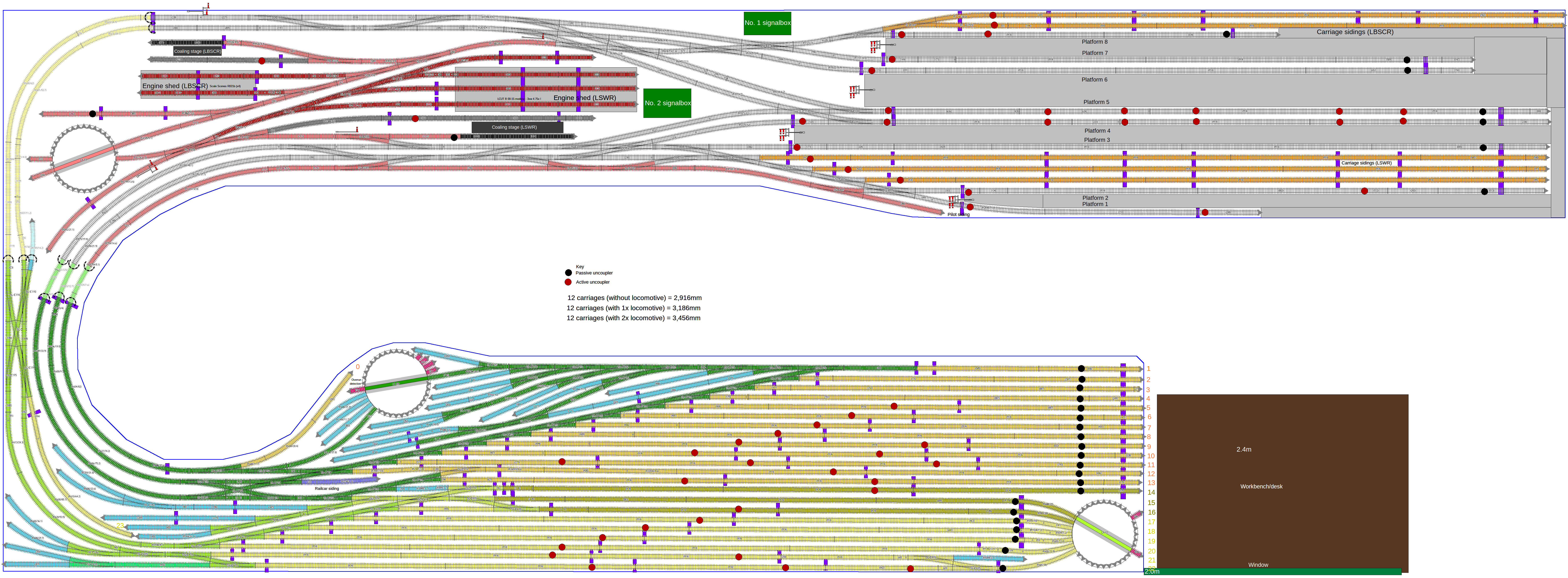Bournahempton [1936 - Southern Railway - 00 - automated]
Posted: Sat Apr 16, 2022 6:00 pm
This is a layout that I have been planning since 2018. I may hopefully be able to start building it this year or next.
Background and location
Having enjoyed railway modelling as a child, I had not engaged with this hobby as an adult until about 2018. In that year, I had a shed built in my garden for the purposes of building some layouts. The original plan was to have an 00 gauge layout representing a London terminus set over two levels: the upper level would represent the main line and the lower level would represent the Underground; they would be connected by way of a helix. I then redesigned the 00 gauge layout to represent a terminus on the south coast of England, and removed the underground section. This allowed me to have a different layout on the lower level. I chose to have an N gauge layout set in 1989 on this lower level.
Woodwork is not my forte, so I had the baseboards professionally made. The company that made them recommended that I have the N gauge layout on the lower level built first, as it would be awkward to lay the track to the rear of that layout if the 00 gauge baseboards had already been installed. This I had done, and the boards for this layout were installed in April 2019. Here are some photographs of the shed shortly after the baseboards were installed:
 Shed by James Petts, on Flickr
Shed by James Petts, on Flickr
 Shed by James Petts, on Flickr
Shed by James Petts, on Flickr
 Shed by James Petts, on Flickr
Shed by James Petts, on Flickr
 Shed by James Petts, on Flickr
Shed by James Petts, on Flickr
Laying the track on the N gauge layout (which, on the scenic section, was kit built from British Finescale) took longer than I had expected and some time was taken trying to overcome some electrical problems, so I was not ready for the 00 gauge baseboards to be built by the time that the pandemic struck. In any event, the Peco Bullhead slips and crossings required for the 00 gauge layout were not then (and still are not) available. I then focussed my efforts on building the N gauge layout, whose trackwork and electrics are now mostly complete (save for some signals the delivery of which I am still awaiting), and I am currently working on the automation of that layout. It will not be wise to install scenery on this layout until the 00 gauge baseboards that go above it have been installed, and all the signals will have to be removed before that installation.
Here is a recent picture of the shed with the N gauge layout in a more complete state:
 After by James Petts, on Flickr
After by James Petts, on Flickr
The time has come to resume progress towards the 00 gauge layout, and I thought that it would be interesting to document that progress here.
Layout concept
The layout is intended to be set on the Southern Railway in 1936 on the south coast of England in the Hampshire area, on the boundary between the former LSWR and LBSCR systems, after the completion of the Brighton electrification but before any further main line electrifications had been completed, the layout being set in non-electrified territory and at the height of the summer season. The following schematic should explain what I have in mind for its setting.
Reality

The world of the layout
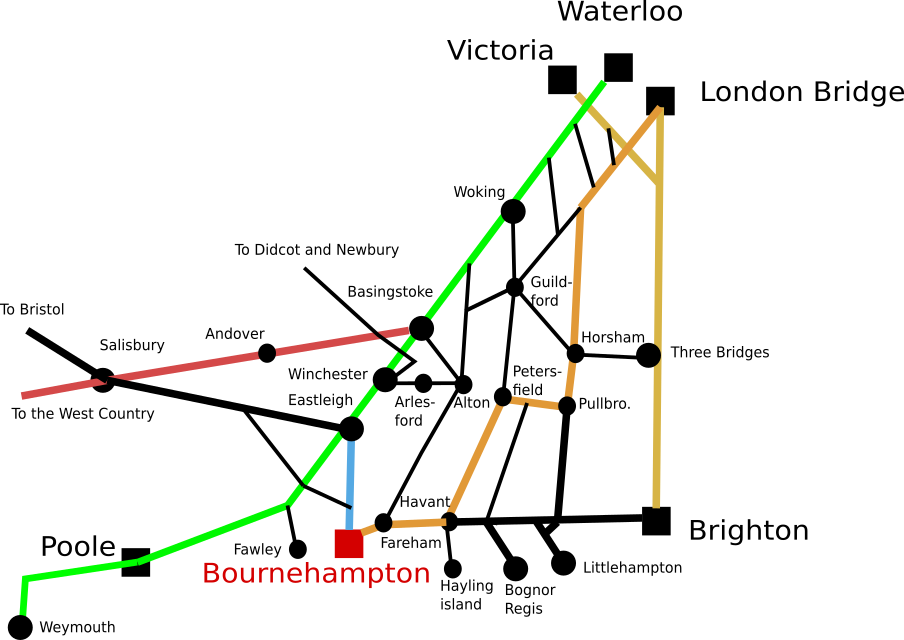
Services will include expresses to Waterloo via Basingstoke, including the non-stop all Pullman "Bournehampton Belle", otherwise comprising an alternating hourly service, one every two hours being non-stop and the intervening services being semi-fasts or portion worked Poole or Weymouth trains that divide/combine at Eastleigh, relief trains for holidaymakers, business expresses to/from London Bridge, with a single Pullman car, a service pattern left over from the LBSC, semi-fasts to London Bridge formed of non-corridor stock, the daily Brighton to Plymouth service, which changes locomotives in Bournehampton, semi-fasts to Brighton, Salisbury, Basingstoke and Weymouth, cross-country services to Cardiff, Swansea, Manchester, Liverpool and various other Northern destinations, and local cross-country services on the Didcot, Newbury & Bournehampton joint line which, for the summer 1936 timetable, is experimentally worked by a GWR Park Royal railcar, local services to Chichester, Fawley, Poole and Eastleigh and parcels trains to London, Brighton and the West Country. This service pattern is fairly closely based on real timetables for Southampton (for the LSWR services) and Portsmouth (for the LBSC services).
Era
As stated above, the layout is intended to be set in 1936. However, it is intended that it should be possible to backdate this by about 20 years to a pre-grouping era if I should ever find that I enjoy building rolling stock kits enough to justify this. The plan is to start with being able to run the layout with bought rolling stock and experiment with kit building later.
The track plan
The track plan has been through many different versions and amendments. This is the latest version:
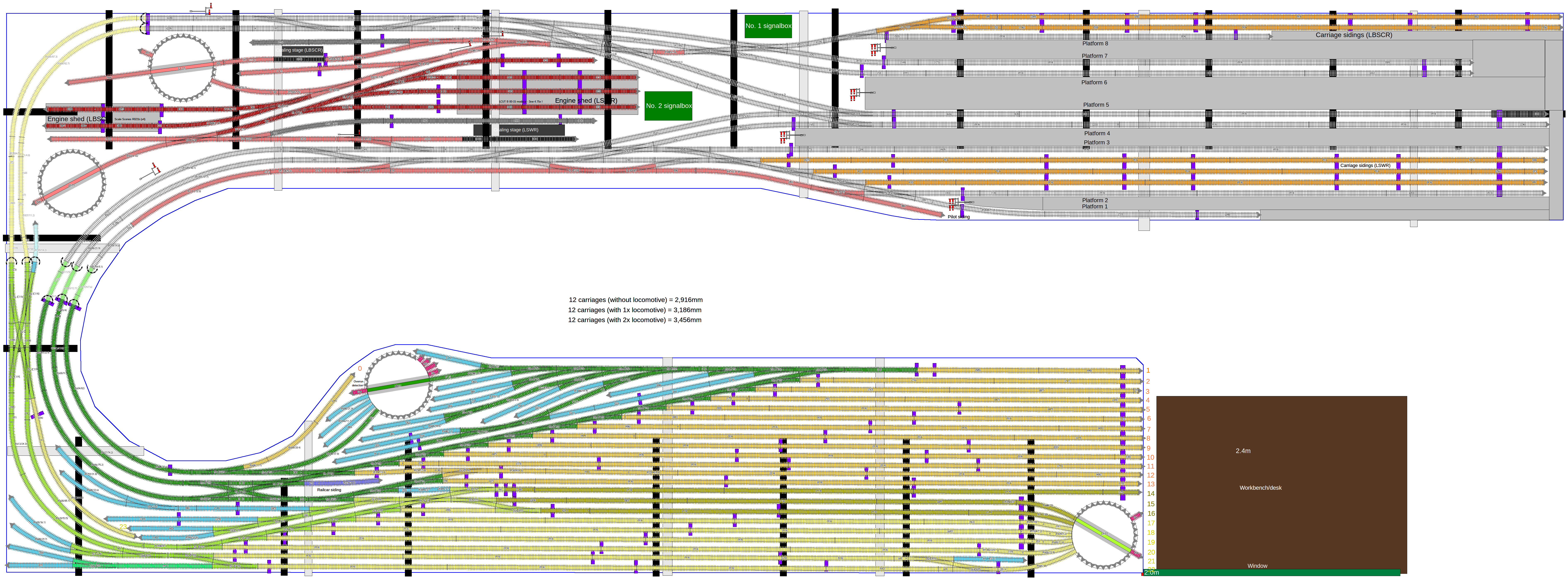
The upper area represents the scenic section and the lower area the fiddle yards. The tracks are colour coded as follows:
* white: main line, scenic section;
* light red: sidings/yards, scenic section;
* dark red: locomotive sheds, scenic section;
* orange: carriage sidings, scenic section;
* green (various): through lines, fiddle yards;
* yellow (various): carriage roads, fiddle yards;
* blue: light engine stabling, fiddle yards;
* purple: railcar stabling, fiddle yards; and
* bright red: turntable overrun sections, fiddle yards.
The outer pair of tracks represent the former LBSC lines towards Brighton and the inner lines represent the former LSWR lines towards Eastleigh. The grey rectangles represent board joints and the black rectangles the support brackets. The smaller purple rectangles represent electrical section breaks for occupancy detection purposes. It is assumed that all turnouts will have such breaks on all exits.
Fitting the layout into the room
Using SCARM allows me easily to produce a 3d representation of my shed and the various layouts within it. Here are some renders of how the interior of the shed will look with this layout in place. The N gauge layout on the lower level, as well as some further planned smaller portable N gauge layouts on the lower level on the other side, are also depicted here, but as baseboards only, without showing any trackwork.
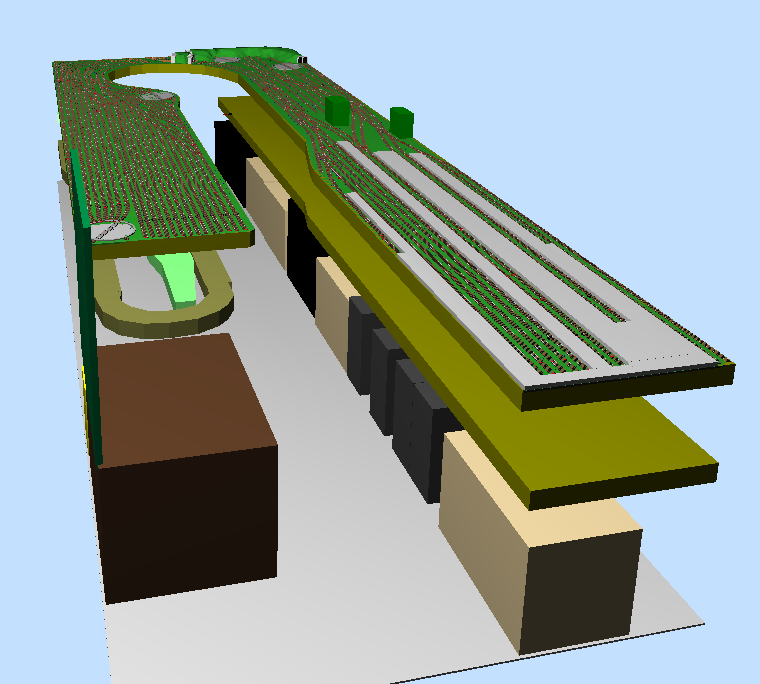
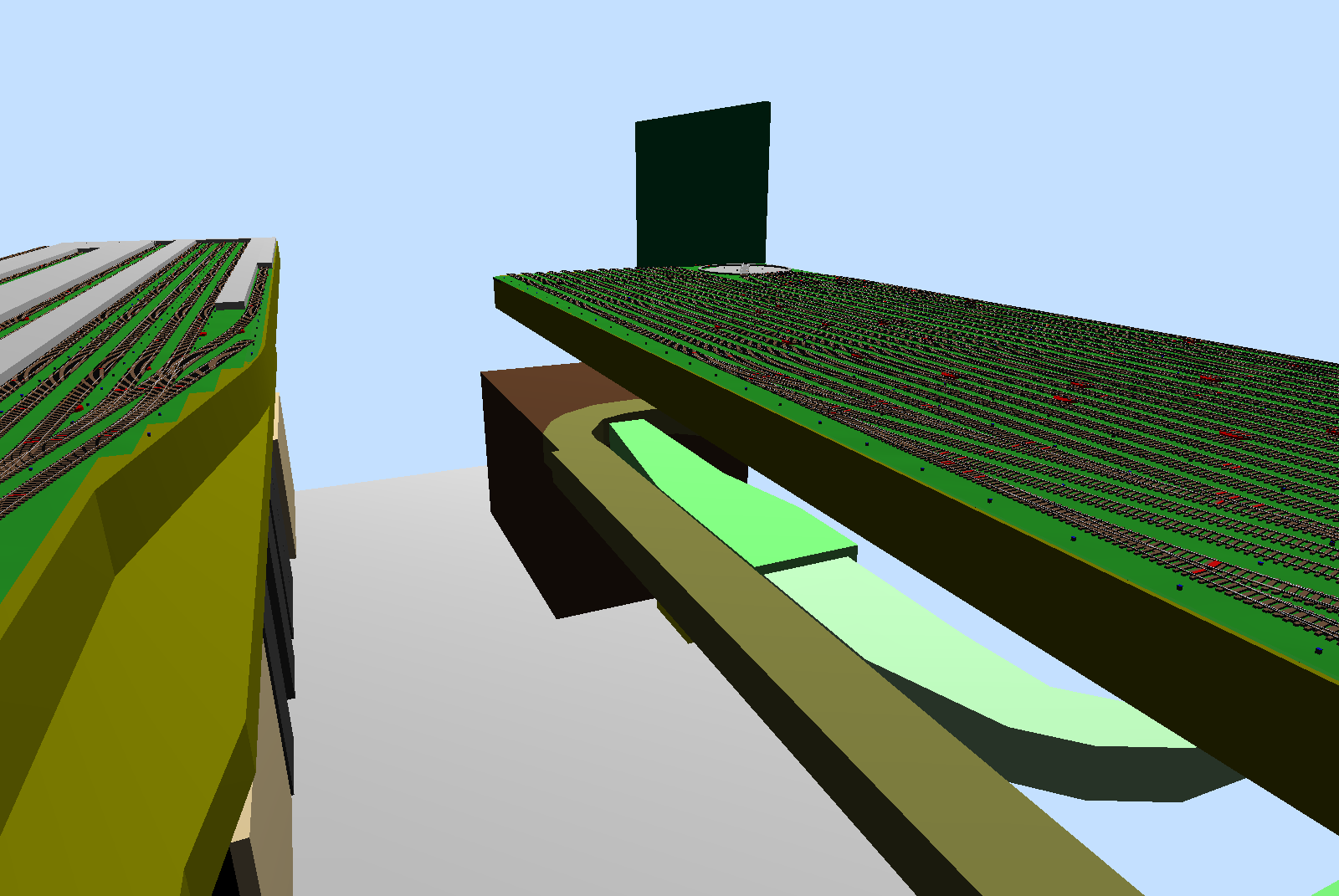
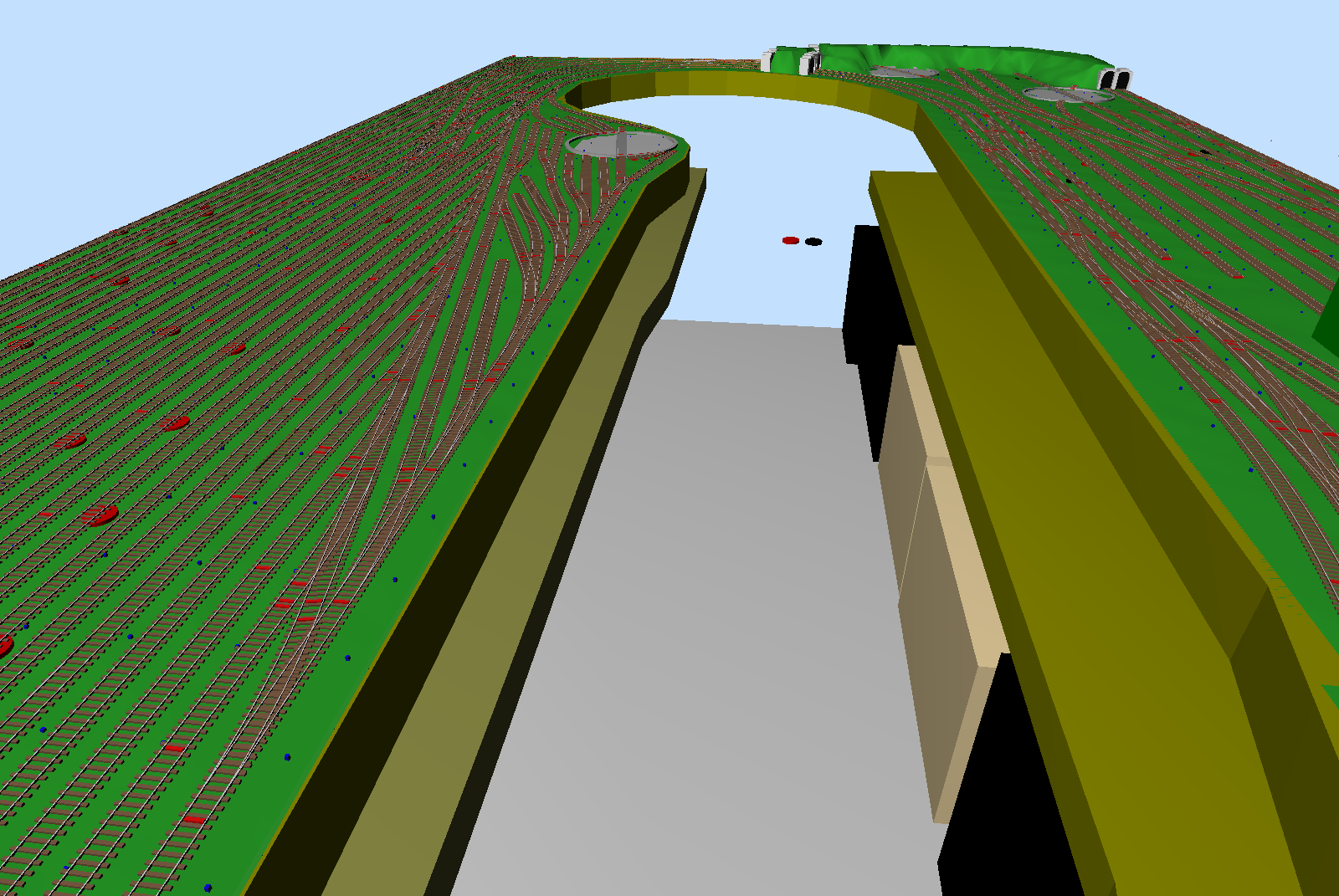
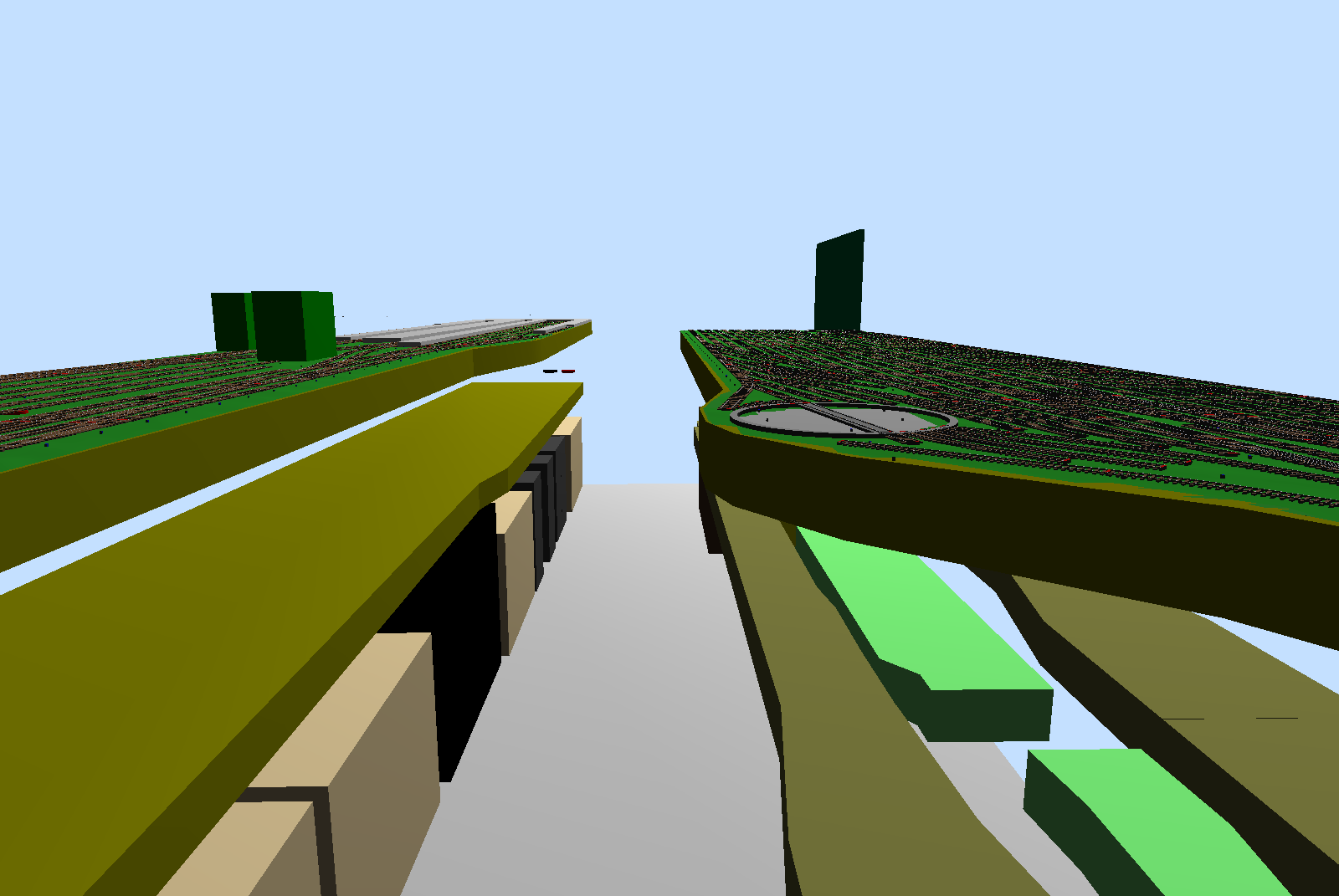
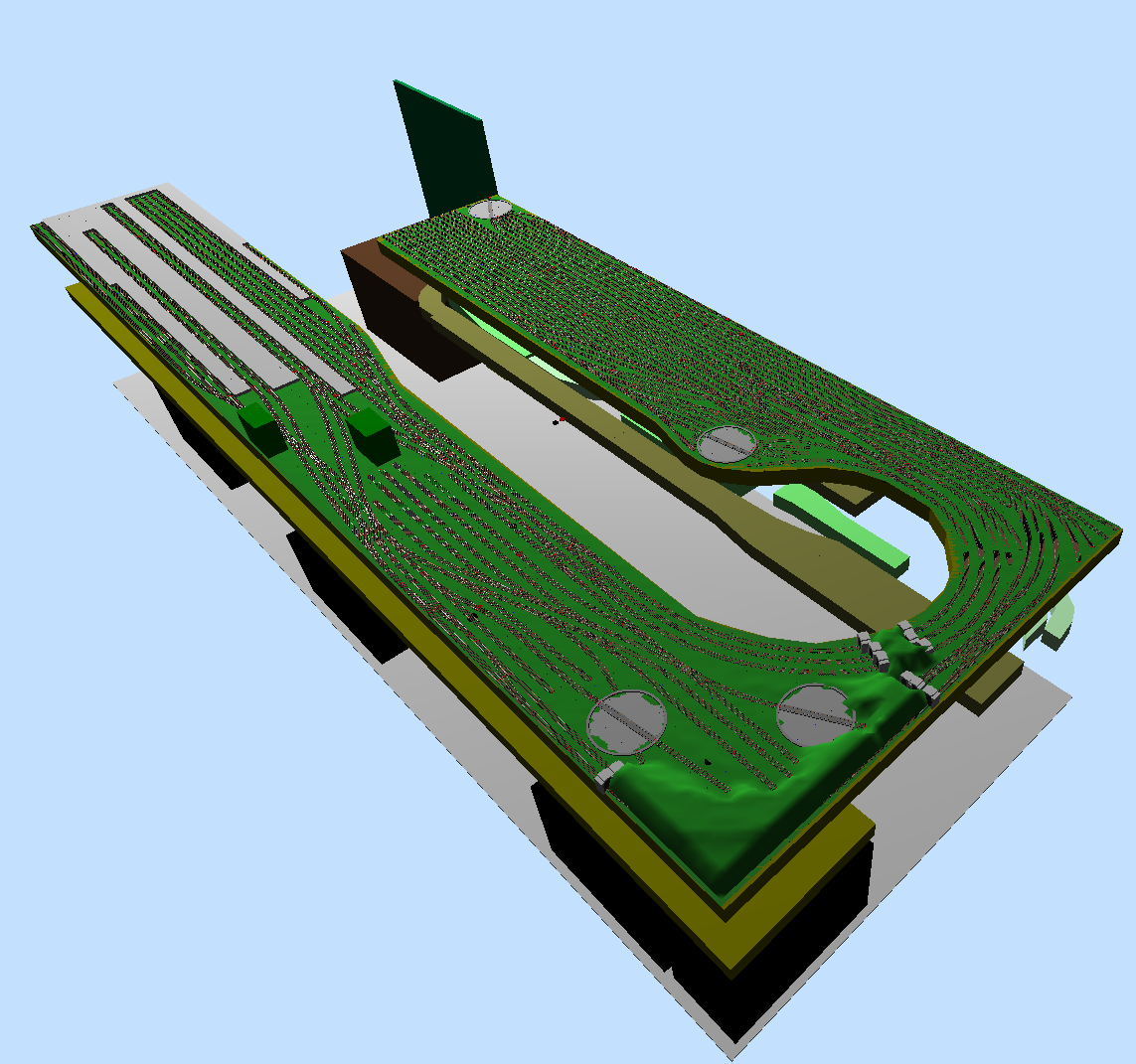
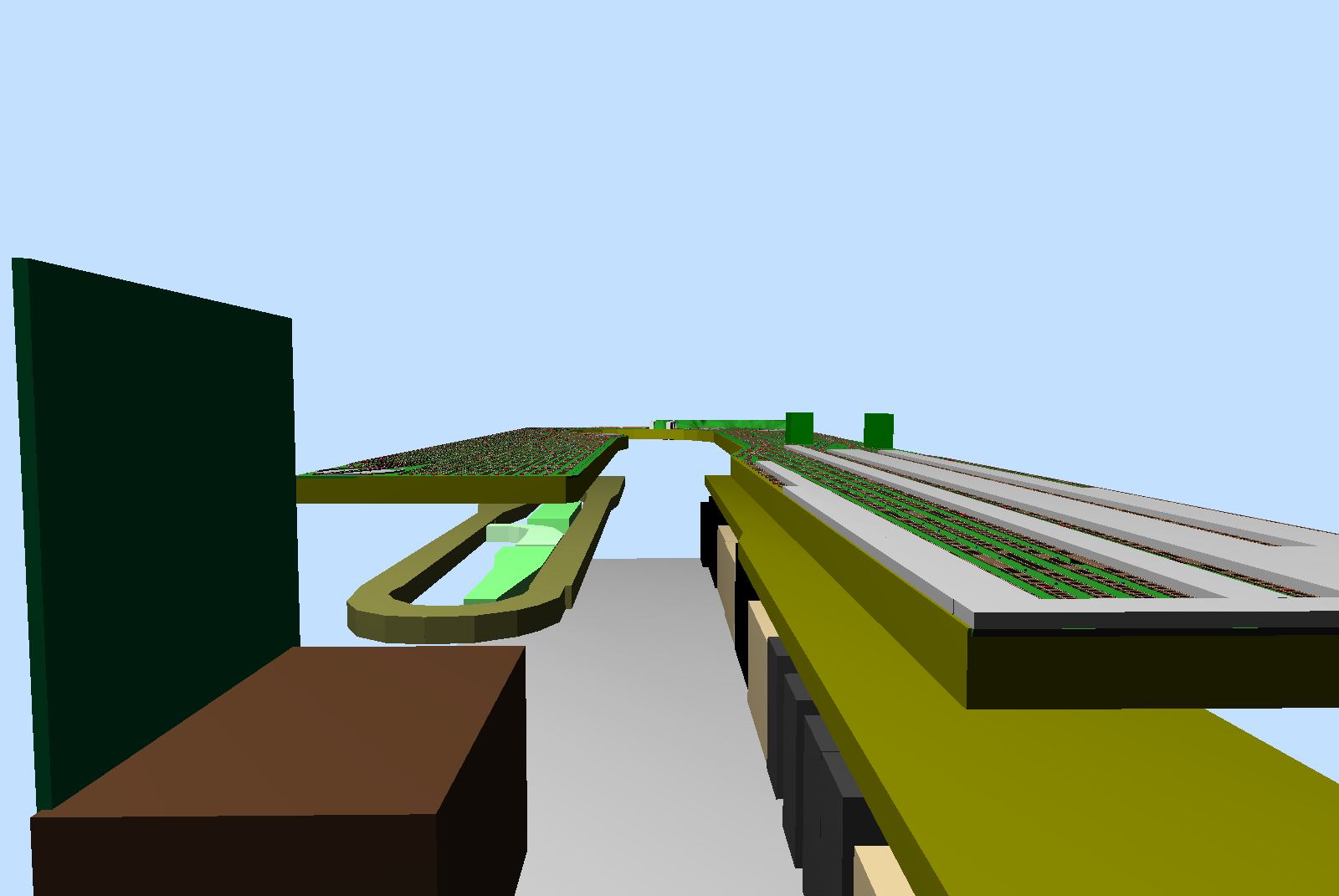
As should be apparent from the pictures, the layout is intended to fit on wall brackets. The plan is for this layout to house lighting for the layout(s) below, which I hope to have computer controlled for a day/night lighting effect.
Electrics and operations
The layout will be DCC and computer controlled/automated using TrainController. The intention is to run to a full week long looping timetable in real time, with optional automatic random disruption. The intention at this stage is for the layout either to be fully automatic, and simply observed, or, optionally, to be able to be set up in a semi-automatic mode, where the trains are driven automatically and the operator(s) take the role of signallers in one or both of the two signalboxes on the layout, for which I hope to build some lever frames. Another possible operator role might be managing the engine (sub-)sheds, but I have not quite worked out how or whether this will work yet.
Full signalling and automatic station announcements are planned. The fiddle yards, too, will be automated, with trains changing locomotives and locomotives being turned automatically: hence the fiddle yard turntables.
Rolling stock
One of the particular joys about modelling the Southern Railway is the enormous variety of pre-grouping locomotives (and, to a lesser extent, carriages) that lived on well into the grouping era. Had there been a much greater variety of pre-grouping motive power and rolling stock available ready to run, this layout would have been set in the pre-grouping era (hence building in the ability to backdate if I acquire a taste for building kits). In its 1936 guise, of course, the older pre-grouping designs would be mixed with relatively more modern designs.
Some highlights include:
 Hornby N15 with detailing applied by James Petts, on Flickr
Hornby N15 with detailing applied by James Petts, on Flickr
the King Arthur class locomotives, which my father tells me that my grandfather used to watch passing by the end of his school playground when he was a nipper;
 Brighton Atlantic on the test tracks by James Petts, on Flickr
Brighton Atlantic on the test tracks by James Petts, on Flickr
the beautiful Brighton Atlantics;
 LSWR D15 with a rake of carriages by James Petts, on Flickr
LSWR D15 with a rake of carriages by James Petts, on Flickr
the D15s;
 Hatton's P class (lined Southern black livery) by James Petts, on Flickr
Hatton's P class (lined Southern black livery) by James Petts, on Flickr
the teeny P class;
 Lord Nelson with Hornby Pullmans by James Petts, on Flickr
Lord Nelson with Hornby Pullmans by James Petts, on Flickr
the mighty Lord Nelson (I had to design the 3d printed smoke deflectors to modify the Hornby model, which was supplied without them in this livery; the STLs are available for free under a Creative Commons licence if anyone is interested);
 OO Works K10 and Hornby T9 by James Petts, on Flickr
OO Works K10 and Hornby T9 by James Petts, on Flickr
the T9s and K10s;
 S. R. V (Schools) and carriages by James Petts, on Flickr
S. R. V (Schools) and carriages by James Petts, on Flickr
the V "Schools" class;
 LSWR 700 and carriages by James Petts, on Flickr
LSWR 700 and carriages by James Petts, on Flickr
the 700 "black motor" class for locomotive coal trains and occasional excursion traffic;
 OO Works LBSC I3 by James Petts, on Flickr
OO Works LBSC I3 by James Petts, on Flickr
the elegant I3;
 O2s by James Petts, on Flickr
O2s by James Petts, on Flickr
the O2 (not to be confused with the entertainment venue in Greenwich);
 Hornby S15 by James Petts, on Flickr
Hornby S15 by James Petts, on Flickr
the S15s, useful for relief workings on summer Saturdays;
and the E4s, M7s and recently released OO Works O4s (of which, for reasons that escape me, I have no photographs).
Current state and progress
At present, the baseboards have yet to be constructed, although, as can be seen, I have a good amount of rolling stock. I am in discussions with the people who built the N gauge baseboards, and awaiting a quote (which the company will now only provide quite shortly before the works are due to start owing to inflation and rapidly fluctuating materials prices).
The scenic section will use Peco Bullhead track, and I thus need to await the availability of the Bullhead slips and crossings, which were supposed to have been available by the end of 2018 but which have been delayed enormously, before starting on this, although I believe that there is at least some suggestion that these may be forthcoming this year. I have removed the few medium radius turnouts that I had formerly inserted into the scenic section as I understand that these will not be available for longer.
Since work may be able to recommence on this before long after a period of nearly 3 years of relative stasis, I have been checking to ensure that all the things that need to be done can be done relatively readily, updating research, revising the track plans, acquiring remaining necessary rolling stock and other matters. One recent change has been in relation to the turntables: because I need turntables that will work with TrainController, I have now specified all the turntables as being of the Peco type, as I intend to use ADM turntables in each location, and I do not want to have to rely on being able to build a bespoke custom turntable from a kit in order to get the layout up and running. The Peco turntables are a bit on the large side, especially if I plan possibly to backdate to the pre-grouping era one day, but I need to plan something that I can be confident can be built to a reliable working standard within a reasonable time. I am minded at this stage to ask the baseboard people to liaise with ADM Turntables to ensure that the turntables be built into the baseboards before they are delivered, as I can see it being extremely difficult to retro-fit the turntables, especially that intended for the LBSC lines (top left) to the scenic section with the N gauge layout underneath.
Background and location
Having enjoyed railway modelling as a child, I had not engaged with this hobby as an adult until about 2018. In that year, I had a shed built in my garden for the purposes of building some layouts. The original plan was to have an 00 gauge layout representing a London terminus set over two levels: the upper level would represent the main line and the lower level would represent the Underground; they would be connected by way of a helix. I then redesigned the 00 gauge layout to represent a terminus on the south coast of England, and removed the underground section. This allowed me to have a different layout on the lower level. I chose to have an N gauge layout set in 1989 on this lower level.
Woodwork is not my forte, so I had the baseboards professionally made. The company that made them recommended that I have the N gauge layout on the lower level built first, as it would be awkward to lay the track to the rear of that layout if the 00 gauge baseboards had already been installed. This I had done, and the boards for this layout were installed in April 2019. Here are some photographs of the shed shortly after the baseboards were installed:
 Shed by James Petts, on Flickr
Shed by James Petts, on Flickr Shed by James Petts, on Flickr
Shed by James Petts, on Flickr Shed by James Petts, on Flickr
Shed by James Petts, on Flickr Shed by James Petts, on Flickr
Shed by James Petts, on FlickrLaying the track on the N gauge layout (which, on the scenic section, was kit built from British Finescale) took longer than I had expected and some time was taken trying to overcome some electrical problems, so I was not ready for the 00 gauge baseboards to be built by the time that the pandemic struck. In any event, the Peco Bullhead slips and crossings required for the 00 gauge layout were not then (and still are not) available. I then focussed my efforts on building the N gauge layout, whose trackwork and electrics are now mostly complete (save for some signals the delivery of which I am still awaiting), and I am currently working on the automation of that layout. It will not be wise to install scenery on this layout until the 00 gauge baseboards that go above it have been installed, and all the signals will have to be removed before that installation.
Here is a recent picture of the shed with the N gauge layout in a more complete state:
 After by James Petts, on Flickr
After by James Petts, on FlickrThe time has come to resume progress towards the 00 gauge layout, and I thought that it would be interesting to document that progress here.
Layout concept
The layout is intended to be set on the Southern Railway in 1936 on the south coast of England in the Hampshire area, on the boundary between the former LSWR and LBSCR systems, after the completion of the Brighton electrification but before any further main line electrifications had been completed, the layout being set in non-electrified territory and at the height of the summer season. The following schematic should explain what I have in mind for its setting.
Reality

The world of the layout

Services will include expresses to Waterloo via Basingstoke, including the non-stop all Pullman "Bournehampton Belle", otherwise comprising an alternating hourly service, one every two hours being non-stop and the intervening services being semi-fasts or portion worked Poole or Weymouth trains that divide/combine at Eastleigh, relief trains for holidaymakers, business expresses to/from London Bridge, with a single Pullman car, a service pattern left over from the LBSC, semi-fasts to London Bridge formed of non-corridor stock, the daily Brighton to Plymouth service, which changes locomotives in Bournehampton, semi-fasts to Brighton, Salisbury, Basingstoke and Weymouth, cross-country services to Cardiff, Swansea, Manchester, Liverpool and various other Northern destinations, and local cross-country services on the Didcot, Newbury & Bournehampton joint line which, for the summer 1936 timetable, is experimentally worked by a GWR Park Royal railcar, local services to Chichester, Fawley, Poole and Eastleigh and parcels trains to London, Brighton and the West Country. This service pattern is fairly closely based on real timetables for Southampton (for the LSWR services) and Portsmouth (for the LBSC services).
Era
As stated above, the layout is intended to be set in 1936. However, it is intended that it should be possible to backdate this by about 20 years to a pre-grouping era if I should ever find that I enjoy building rolling stock kits enough to justify this. The plan is to start with being able to run the layout with bought rolling stock and experiment with kit building later.
The track plan
The track plan has been through many different versions and amendments. This is the latest version:

The upper area represents the scenic section and the lower area the fiddle yards. The tracks are colour coded as follows:
* white: main line, scenic section;
* light red: sidings/yards, scenic section;
* dark red: locomotive sheds, scenic section;
* orange: carriage sidings, scenic section;
* green (various): through lines, fiddle yards;
* yellow (various): carriage roads, fiddle yards;
* blue: light engine stabling, fiddle yards;
* purple: railcar stabling, fiddle yards; and
* bright red: turntable overrun sections, fiddle yards.
The outer pair of tracks represent the former LBSC lines towards Brighton and the inner lines represent the former LSWR lines towards Eastleigh. The grey rectangles represent board joints and the black rectangles the support brackets. The smaller purple rectangles represent electrical section breaks for occupancy detection purposes. It is assumed that all turnouts will have such breaks on all exits.
Fitting the layout into the room
Using SCARM allows me easily to produce a 3d representation of my shed and the various layouts within it. Here are some renders of how the interior of the shed will look with this layout in place. The N gauge layout on the lower level, as well as some further planned smaller portable N gauge layouts on the lower level on the other side, are also depicted here, but as baseboards only, without showing any trackwork.






As should be apparent from the pictures, the layout is intended to fit on wall brackets. The plan is for this layout to house lighting for the layout(s) below, which I hope to have computer controlled for a day/night lighting effect.
Electrics and operations
The layout will be DCC and computer controlled/automated using TrainController. The intention is to run to a full week long looping timetable in real time, with optional automatic random disruption. The intention at this stage is for the layout either to be fully automatic, and simply observed, or, optionally, to be able to be set up in a semi-automatic mode, where the trains are driven automatically and the operator(s) take the role of signallers in one or both of the two signalboxes on the layout, for which I hope to build some lever frames. Another possible operator role might be managing the engine (sub-)sheds, but I have not quite worked out how or whether this will work yet.
Full signalling and automatic station announcements are planned. The fiddle yards, too, will be automated, with trains changing locomotives and locomotives being turned automatically: hence the fiddle yard turntables.
Rolling stock
One of the particular joys about modelling the Southern Railway is the enormous variety of pre-grouping locomotives (and, to a lesser extent, carriages) that lived on well into the grouping era. Had there been a much greater variety of pre-grouping motive power and rolling stock available ready to run, this layout would have been set in the pre-grouping era (hence building in the ability to backdate if I acquire a taste for building kits). In its 1936 guise, of course, the older pre-grouping designs would be mixed with relatively more modern designs.
Some highlights include:
 Hornby N15 with detailing applied by James Petts, on Flickr
Hornby N15 with detailing applied by James Petts, on Flickrthe King Arthur class locomotives, which my father tells me that my grandfather used to watch passing by the end of his school playground when he was a nipper;
 Brighton Atlantic on the test tracks by James Petts, on Flickr
Brighton Atlantic on the test tracks by James Petts, on Flickrthe beautiful Brighton Atlantics;
 LSWR D15 with a rake of carriages by James Petts, on Flickr
LSWR D15 with a rake of carriages by James Petts, on Flickrthe D15s;
 Hatton's P class (lined Southern black livery) by James Petts, on Flickr
Hatton's P class (lined Southern black livery) by James Petts, on Flickrthe teeny P class;
 Lord Nelson with Hornby Pullmans by James Petts, on Flickr
Lord Nelson with Hornby Pullmans by James Petts, on Flickrthe mighty Lord Nelson (I had to design the 3d printed smoke deflectors to modify the Hornby model, which was supplied without them in this livery; the STLs are available for free under a Creative Commons licence if anyone is interested);
 OO Works K10 and Hornby T9 by James Petts, on Flickr
OO Works K10 and Hornby T9 by James Petts, on Flickrthe T9s and K10s;
 S. R. V (Schools) and carriages by James Petts, on Flickr
S. R. V (Schools) and carriages by James Petts, on Flickrthe V "Schools" class;
 LSWR 700 and carriages by James Petts, on Flickr
LSWR 700 and carriages by James Petts, on Flickrthe 700 "black motor" class for locomotive coal trains and occasional excursion traffic;
 OO Works LBSC I3 by James Petts, on Flickr
OO Works LBSC I3 by James Petts, on Flickrthe elegant I3;
 O2s by James Petts, on Flickr
O2s by James Petts, on Flickrthe O2 (not to be confused with the entertainment venue in Greenwich);
 Hornby S15 by James Petts, on Flickr
Hornby S15 by James Petts, on Flickrthe S15s, useful for relief workings on summer Saturdays;
and the E4s, M7s and recently released OO Works O4s (of which, for reasons that escape me, I have no photographs).
Current state and progress
At present, the baseboards have yet to be constructed, although, as can be seen, I have a good amount of rolling stock. I am in discussions with the people who built the N gauge baseboards, and awaiting a quote (which the company will now only provide quite shortly before the works are due to start owing to inflation and rapidly fluctuating materials prices).
The scenic section will use Peco Bullhead track, and I thus need to await the availability of the Bullhead slips and crossings, which were supposed to have been available by the end of 2018 but which have been delayed enormously, before starting on this, although I believe that there is at least some suggestion that these may be forthcoming this year. I have removed the few medium radius turnouts that I had formerly inserted into the scenic section as I understand that these will not be available for longer.
Since work may be able to recommence on this before long after a period of nearly 3 years of relative stasis, I have been checking to ensure that all the things that need to be done can be done relatively readily, updating research, revising the track plans, acquiring remaining necessary rolling stock and other matters. One recent change has been in relation to the turntables: because I need turntables that will work with TrainController, I have now specified all the turntables as being of the Peco type, as I intend to use ADM turntables in each location, and I do not want to have to rely on being able to build a bespoke custom turntable from a kit in order to get the layout up and running. The Peco turntables are a bit on the large side, especially if I plan possibly to backdate to the pre-grouping era one day, but I need to plan something that I can be confident can be built to a reliable working standard within a reasonable time. I am minded at this stage to ask the baseboard people to liaise with ADM Turntables to ensure that the turntables be built into the baseboards before they are delivered, as I can see it being extremely difficult to retro-fit the turntables, especially that intended for the LBSC lines (top left) to the scenic section with the N gauge layout underneath.




